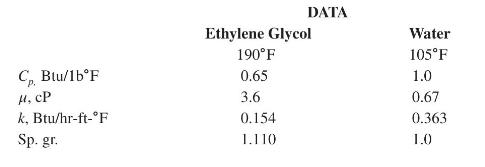Ethylene glycol at 100,000 (mathrm{lb} / mathrm{hr}) enters the shell of a 1-6 shell-and-tube heat exchanger at
Question:
Ethylene glycol at 100,000 \(\mathrm{lb} / \mathrm{hr}\) enters the shell of a 1-6 shell-and-tube heat exchanger at \(250^{\circ} \mathrm{F}\) and is cooled to \(130^{\circ} \mathrm{F}\) with cooling water heated from 90 to \(120^{\circ} \mathrm{F}\). Assume that the mean overall heat-transfer coefficient (based on the inside area of the tubes) is \(100 \mathrm{Btu} /\left(\mathrm{ft}^{2}-\mathrm{hr}^{\circ} \mathrm{F}\right)\) and the tube-side velocity is \(5 \mathrm{ft} / \mathrm{sec}\). Use \(3 / 4\)-in. . 16 BWG tubing (O.D. \(=0.75\) in., I.D. \(=0.62\) in.) arranged on a 1 -in. square pitch.
(a) Calculate the number of tubes, length of the tubes, and tube-side heat-transfer coefficient.
(b) Calculate the shell-side heat-transfer coefficient to give an overall heat-transfer coefficient of \(100 \mathrm{Btu} /\left(\mathrm{ft}^{2}-\mathrm{hr}^{\circ}{ }^{\circ} \mathrm{F}\right)\).

Step by Step Answer:

Product And Process Design Principles Synthesis Analysis And Evaluation
ISBN: 9781119355243
4th Edition
Authors: Warren D. Seider, Daniel R. Lewin, J. D. Seader, Soemantri Widagdo, Rafiqul Gani, Ka Ming Ng





